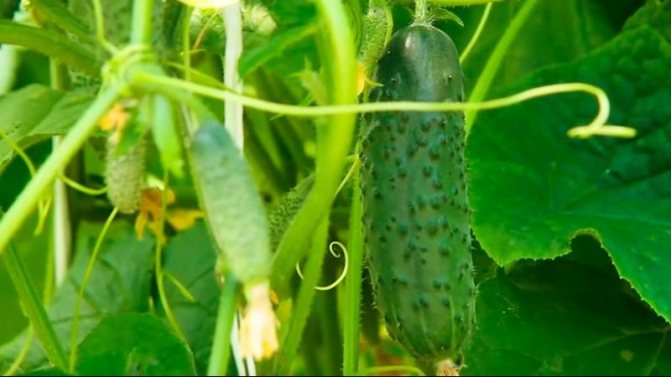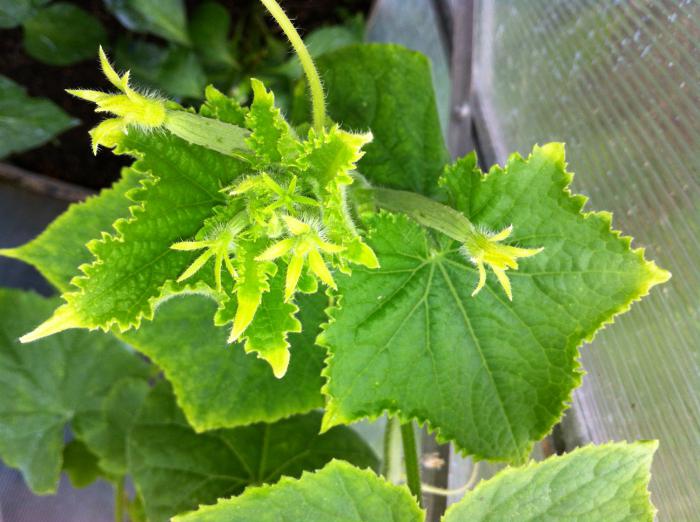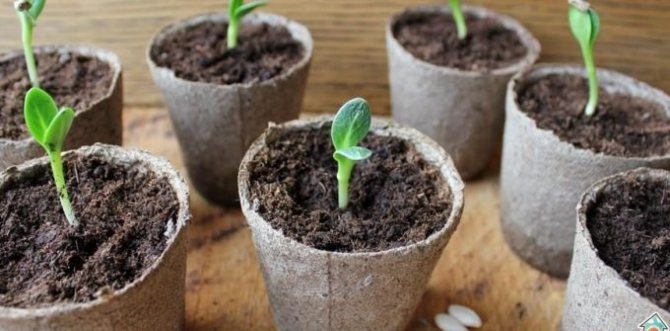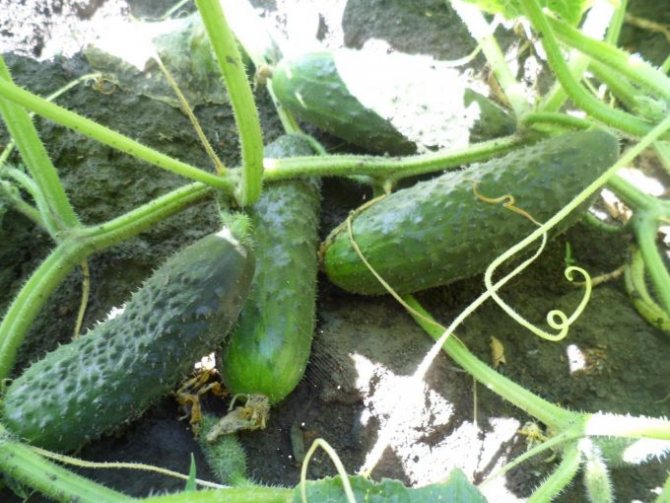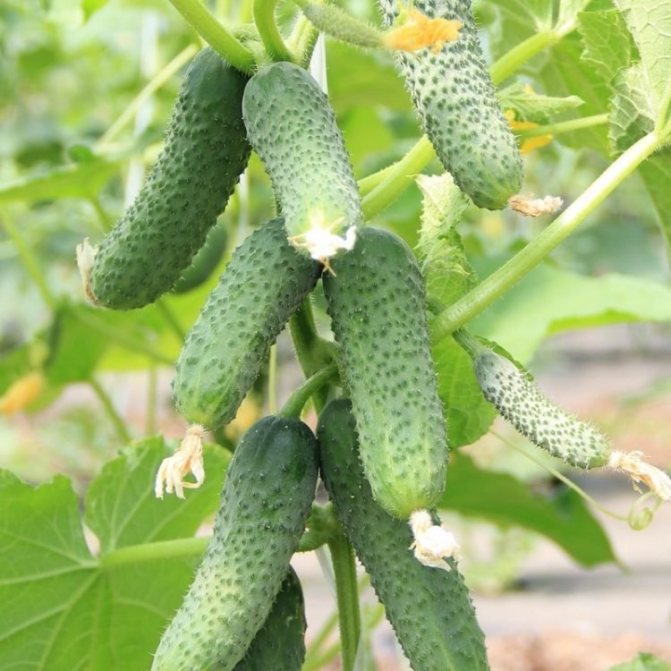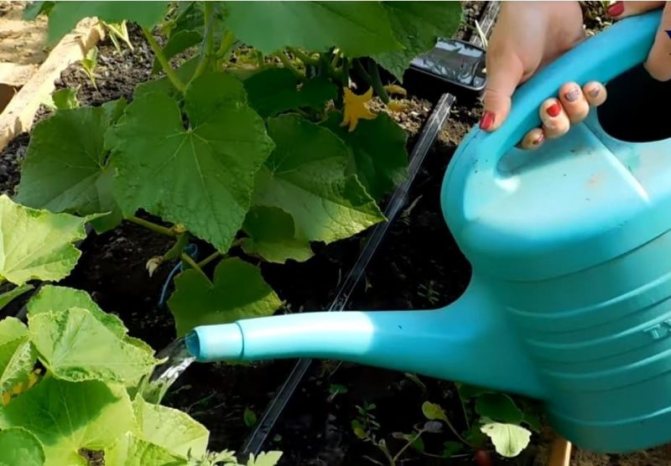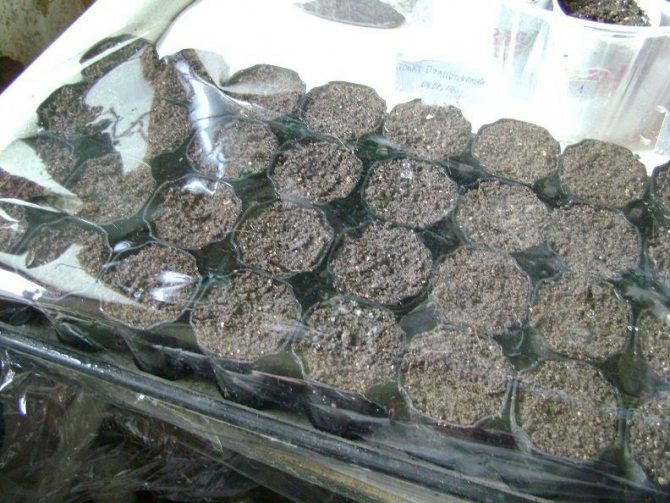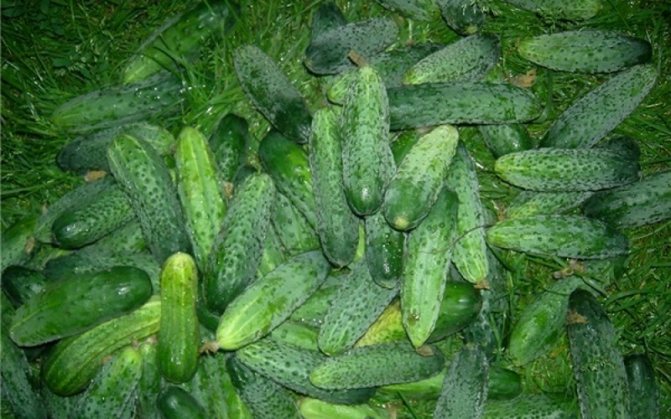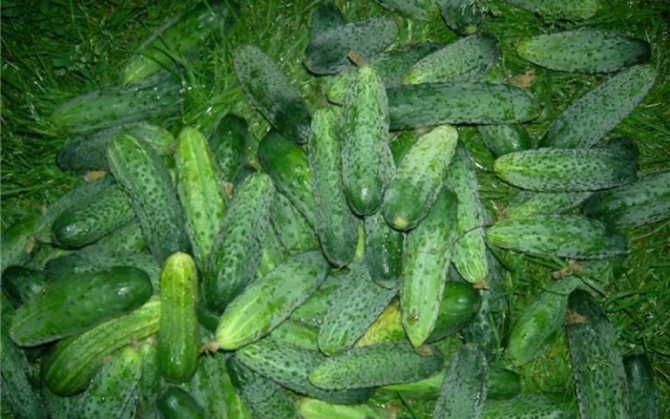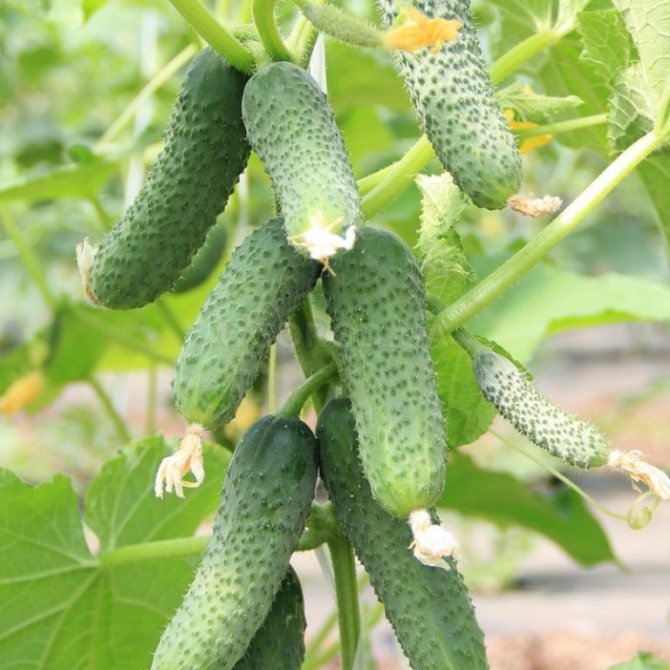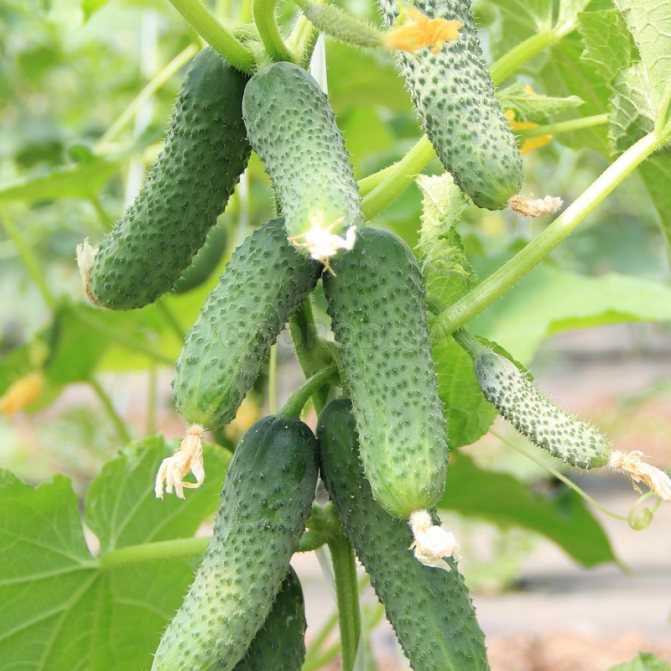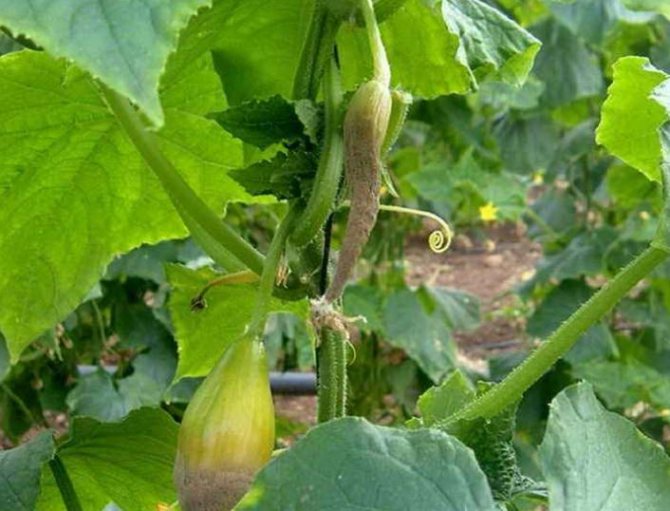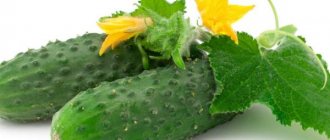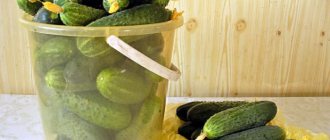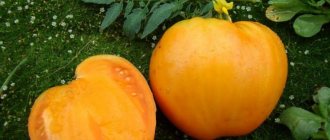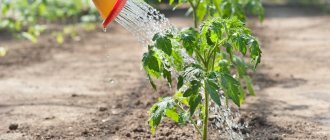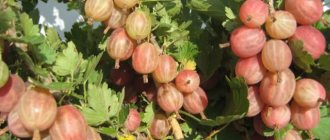Vegetable growing »Cucumbers
0
1169
Article rating
cucumber variety Mother-in-law and Zyatek - a hybrid of two types. It is very popular with vegetable growers. It is unpretentious and easy to grow, immune to various diseases and has excellent taste characteristics. You will definitely not regret if you plant it in your garden!
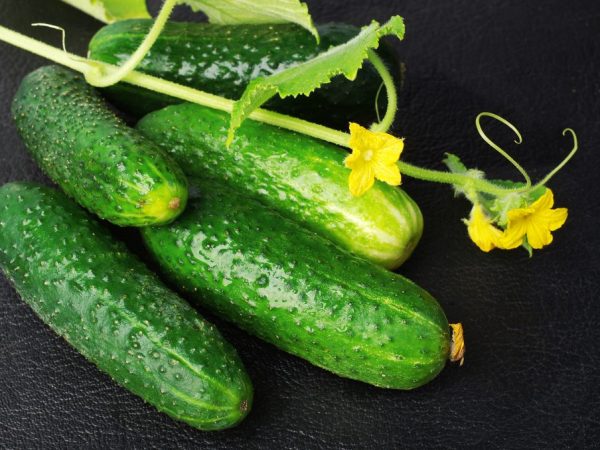
Features of the variety of cucumbers Mother-in-law and Zyatek
Selection characteristic
Mother-in-law's hybrid cucumbers were bred by Russian breeders from the Research Institute of Greenhouse Vegetable Growing, in collaboration with seed scientists, Moscow. The plant got into the State Register of Breeding Achievements of the Russian Federation in 2007, and since then it has been increasingly found in various regions of the state. The developers of the new variety did a good job of adapting it to growing not only in the Central, but also in the Northern and Middle Volga regions, therefore, with proper preparation of the site and the planting material itself, it will not be a problem to grow it in any climate.


Mother-in-law F1 is a vigorous plant, with medium lashes and cylindrical greens, which grow up to 11-13 cm in length and gain weight up to 125 g each. The surface of the fruit is lumpy and brownish, the pulp is dense, without voids and characteristic bitterness in taste.
The first crop can be harvested within 48 days after sowing the seeds, and from 1 m² it is often possible to get up to 12 kg of high-quality fruits. All of them have a pleasant and delicate taste that does not change even after prolonged storage of cucumbers.
Did you know? The peculiarities of the peel of cucumbers determine their attractiveness to people of different nationalities. While for Russians the pimply varieties of this vegetable are considered real, European consumers call them "Russian shirts" and prefer fruits with a smooth surface.
The history of the cucumber Zyatek
The author of the hybrid is one of the leaders of the Russian seed market - agro. The son-in-law was created with the assistance of scientists from the Moscow Research Institute of Agriculture. These two organizations became the originators, that is, they are responsible for the safety and purity of the variety.
has been engaged in breeding for over 20 years, initially became famous as a tomato. More than 400 varieties and hybrids of tomatoes have been entered into the State Register: Evpator, Babushkino basket, Big Mom, Sugar Nastasya, Pervoklashka, etc.
And today "Gavrish" is also proud of its cucumbers. The first masterpiece was the high-yielding Courage with a bundle ovary. Zyatok, along with other hybrids of the same selection, adequately complements the rich and interesting assortment. By the way, the mother-in-law's cucumber was created in a pair of Zyatka in the same year. The seeds of these literally relatives are packed in one package (but each in its own mini-package), and separately.
Video: an overview of cucumbers from "Gavrish"
Advantages and disadvantages
- The main advantages of the mother-in-law's hybrid cucumber variety include the following characteristics:
- high taste data;
- increased productivity;
- gradual ripening of fruits (prolongs the harvesting period);
- high rates of seed germination;
- versatility of use (suitable both for fresh consumption and for processing into blanks);
- the ability to grow in any type of soil and in any climatic conditions;
- no need for insect pollination;
- good resistance to powdery mildew and downy mildew.
- Among the disadvantages of this hybrid variety of cucumbers are:
- relatively high cost of planting material;
- whimsical care, taking into account the requirements for watering, tillage and fertilization.
Reviews of gardeners
The following is an overview of the opinions of amateur farmers about cucumbers Mother-in-law F1.
Gennady, Voronezh: «We have been looking for cucumbers suitable for our greenhouse for a long time. We tried several, but opted for the F1 Mother-in-law. Simultaneous emergence of seedlings, quick adaptation to greenhouse conditions, early maturity and good transportation are the main reasons that today we are planting only Mother-in-law F1 ”.
Victoria, Cherepovets: “The hybrid attracts me with its unpretentiousness and productivity. It is not a hassle to care for, but we definitely tie up the bushes (the harvest is easier at the same time). For 3 years of cultivation, a single attack of aphids is the only problem. "
Svetlana, Krasnodar: “We planted the F1 mother-in-law last spring. The season was unsuccessful: rains, temperature changes, cold. But the chosen hybrid perfectly endured all difficulties and pleased with a good harvest. Zelentsov was enough for both food and salting, although we planted only 15 bushes. "
Self-cultivation of seedlings
In the greater territory of the Russian Federation, the cultivation of Mother-in-law's cucumbers provides for their preliminary sowing for seedlings, because sufficient heating of the soil is observed not earlier than the beginning or even the end of May. The specific timing of sowing seeds must be taken into account at home, just like the requirements for the preparation of the substrate and the technology for placing the planting material in prepared containers.
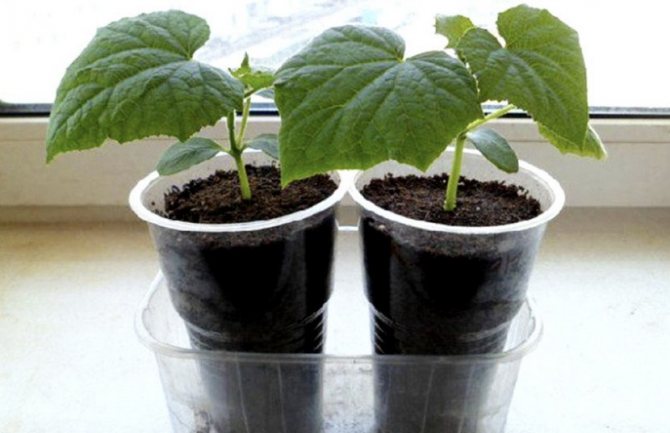

Optimal sowing time
Sowing cucumbers in seedling boxes is carried out about a month before planting in a permanent place of growth. The ideal age of young cucumber seedlings for transplanting them to the garden is considered to be 20-25 days from the moment of sowing the seedlings, that is, if it is planned for mid-May (the air temperature should reach + 22 ... + 28ºC during the day, and up to + 18… + 22ºC at night ), then sowing seeds can be done already in mid-April. A decrease in these values to + 8ºC, which persists for more than two days, threatens the destruction of plantings.
Read more about the timing of planting cucumbers for seedlings.
The soil
Light, nutritious soils with neutral acidity are considered an ideal substrate for cucumber seedlings. You can buy such soil ready-made (sold in any gardening store) or prepare it yourself by mixing peat or leafy soil (1 bucket), sand (0.5 buckets) and ash (1 l). Ash can be replaced with dolomite flour or lime, which is especially valuable when it comes to substrates with high acidity.
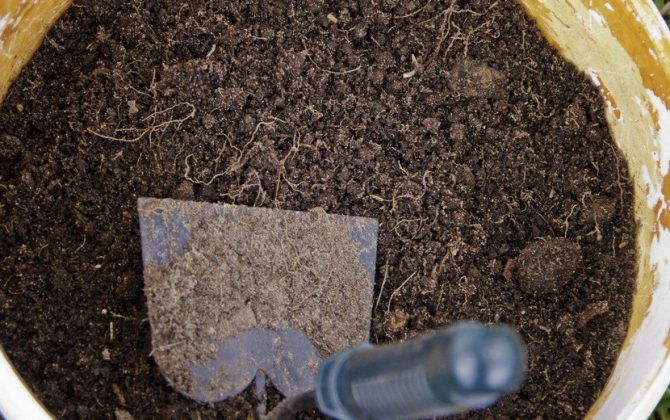

Also, do not forget that such a mixture will not contain any nutrients, which means that it is worth adding to it at least 3 tbsp. spoons of any complex fertilizer. In the future, during the growth of seedlings, instead of pure water for irrigation, you will have to use a mixture of liquid with complex fertilizers each time (they must include potassium, phosphorus and nitrogen).
Alternatively, you can use a mixture of two parts turf, one part compost or peat and the same amount of sand (or perlite). When mixing all the ingredients, always try to get a homogeneous mixture, without any lumps.
Important! Before use, the finished commercial substrate must be disinfected by placing a bag with it in a bucket with very hot (up to +70
° C
) with water. It is imperative to cover the bucket with a lid and leave the soil in this form until the water cools completely.
You can also disinfect a self-prepared substrate by baking it in the oven or spilling it with a weak solution of potassium permanganate.
Growing tank
For sowing cucumber seeds, almost any container is suitable.This can be a small plastic box, individual plastic boxes, or special cassettes with separate wells. Peat pots are also a good option for placing seeds, but they are not required. If earlier seedlings were already grown in the container, then before reuse it should be scalded.
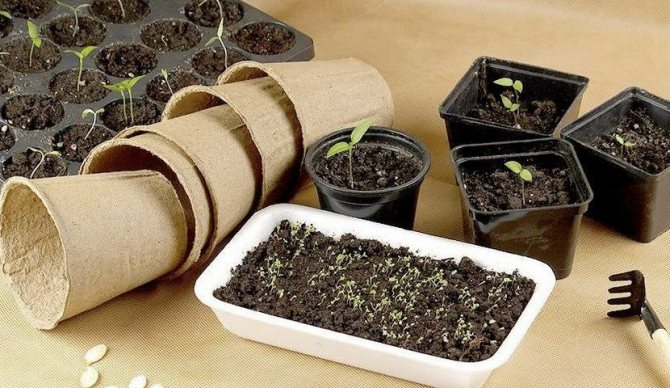

Seed preparation
Pre-planting preparation is needed not only for the soil, but also for the seeds of Mother-in-law's cucumbers. Having chosen only high-quality planting material (all seeds should be even and about the same size), it is immersed in a weak solution of potassium permanganate and left there for 30 minutes. After the specified time, it remains only to rinse the seeds in clean water and dry a little before sowing into the soil. Instead of potassium permanganate, you can also use special prophylactic preparations (for example, "Fitosporin-M"), which will help protect future seedlings from root rot and bacteriosis.
For the rapid germination of planting material (especially in depleted soils), they are additionally soaked in solutions for root formation, such as "Epin" or "Zircon", but not less than 12 hours.
Sowing
The scheme for planting mother-in-law's cucumbers in seedling containers depends on the type of prepared container. For example, you can place 2-3 seeds in separate cups, deepening each of them 2-3 cm into the soil. When using boxes, sowing of planting material should be carried out taking into account the required distance between neighboring plants: not less than 5 cm. The grooves are made at a distance of 10-15 cm from each other.
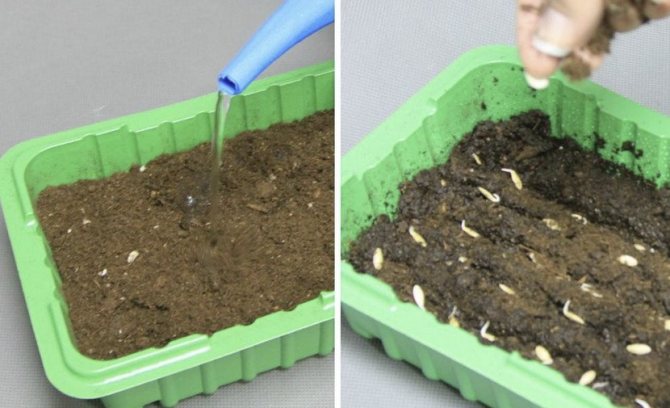

As for the technology for performing the process, it provides for a standard set of planting actions:
- To begin with, the prepared soil is leveled and the corresponding grooves are made in it, 3 cm deep.
- Then the soil is slightly moistened and the prepared seeds are placed in it, observing the required distance, according to the above scheme.
- At the end of the process, the seeds of the cucumbers are covered with soil and the boxes are covered with glass or plastic wrap.
At the initial stages of growing, it is better to place seedlings in a dark place, with an air temperature of at least + 20ºC. After the appearance of young shoots, the boxes are transferred to a light windowsill and the film cover is removed.
Seedling care
For seedlings that have emerged from the ground, a sufficient level of lighting is an important condition for their normal growth and development. However, it is desirable that it be scattered, otherwise immature sprouts may get burned. The first watering is usually performed a few days after sowing the seeds, focusing on the condition of the soil: the dried upper layer of the substrate is always slightly moistened so that a dense crust does not appear on it. A few hours after applying the liquid, the soil in the boxes can be loosened using a small stick or even a match, deepened into the areas between the plants. It is better not to perform the procedure before the emergence of shoots, since there is a high probability of getting the planted seeds out of the ground.
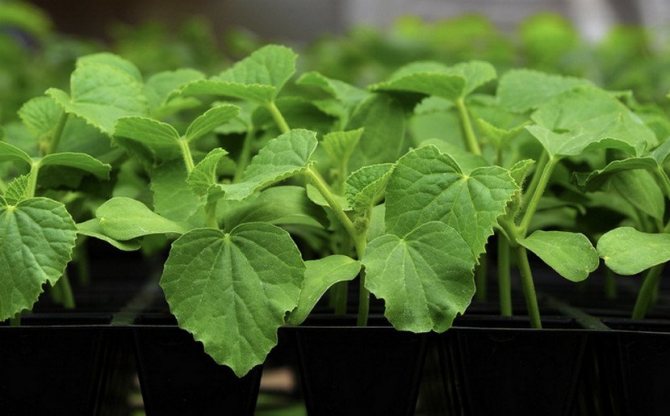

As for fertilizers, in a month of growing mother-in-law's cucumber seedlings, you can use complex mineral compositions twice, combining their application with the next watering of the plantings. Approximately 2-3 weeks after sowing, the grown plants can be sown from a common box in separate cups (dive). Very weak shoots should be removed, leaving only strong and healthy specimens.
About a week before the grown seedlings are planted in a permanent place of growth in the open field, they begin to harden it. In the early days, it is enough to take the boxes with seedlings out onto a closed balcony and leave them there for 1-2 hours, and after another 2-3 days, the time the seedlings stay in a cool place is increased to 4-5 hours.On warm days, the windows on the balcony can be opened, the main thing is to protect the cucumber seedlings from sudden gusts of cold air.
Did you know? The record for growing the longest cucumbers belongs to British pensioner Claire Pierce, who managed to grow a vegetable that is 119 cm long.
How to grow a good harvest
Subject to the basic rules for caring for garden plants of the pumpkin family, it is not difficult to grow hybrid varieties Mother-in-law and Zyatek. Stick to the rules of the professionals, and then you will be assured of a great harvest.
Secrets of a great seedling
These cucumbers can be grown in two ways. The first is by planting seedlings in advance. The second is to immediately sow seeds into the ground.
Please note that the time when the first seedlings will sprout is largely influenced by the air temperature. The weather is cool enough (no more than 13 ° C) - this means that the seeds will not be able to germinate. If the temperature warms up to 15-20 ° C, the first shoots on the garden bed will appear in about ten days. It is really warm and summer weather on the street - wait for the shoots in 5 days. It is necessary to sow the cucumber variety Zyatek and Mother-in-law f1 in open ground at the end of May.
But it is best to start growing seedlings in April, because in a month it will need to be planted in the garden. First you need to carefully sort the planting material, selecting healthy and whole seeds.
Then you should prepare containers for breeding seedlings. Disposable cups are best suited for these purposes. Fill them with a mixture of soil and peat.
Purchase the earth in advance in a specialized store, then you will definitely be sure that it is not contaminated with any bacteria. Seeds are planted not deeply and germinate within a month. The sprouts are transferred to the garden bed only after they gain strength and they grow from 2 to 3 leaves. Saplings are planted according to the scheme 55x90 cm.
Planting and growing cucumbers
Growing cucumbers of the Mother-in-law variety is possible both in a seedling and a non-seedling way., each of which, although it has its own characteristics, but at the same time provides for the fulfillment of general requirements: for example, the organization of nutrient soil for cucumbers (rotted humus, manure and superphosphate must be introduced into depleted soils, which is sometimes better to replace with wood ash).


The acidity of a suitable substrate will always tend to zero, and the friability should be at the highest possible level. In already used soil, cucumbers can be re-grown no earlier than after 3-4 years. As for the specific features of seedling and seedling planting, it is important to consider the following features.
Seedling method
For seedlings, mother-in-law's cucumbers are sown in the middle or end of April, preparing the soil and the seeds themselves in advance in the above way. At the stage of formation of 3-4 true leaves (approximately 25 days from the moment of sowing), the plants are ready for transplantation to a permanent place of growth, which on average falls on the middle or end of May, when the threat of recurrent frosts has completely passed. The planting of seedlings on the garden bed is carried out according to the 50 × 50 cm scheme, which guarantees sufficient space for the growth of any bush. For a few hours to move the grown cucumbers, it is useful to spill them with warm water, which will facilitate the process of removing the seedlings from the seedling containers.
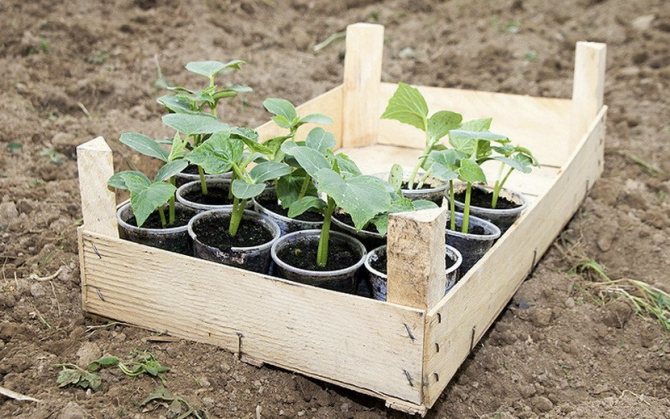

For the successful adaptation of young plants to the new soil, its temperature should be at least + 13ºC, and as for a suitable planting time, then it is worth paying attention to cloudy weather, without direct exposure of the soil to direct sunlight.
In harsh climatic regions, above vertically planted shoots (each plant must take a stable position), it is useful to stretch a temporary film cover that protects the cucumbers from possible return frosts.
In a reckless way
In warm regions, it is often practiced to sow cucumber seeds directly into open soil, so the planting dates in this case will be slightly shifted: around the end of May or the beginning of June. On a previously dug, fertilized and loosened bed, it is necessary to organize furrows with a depth of about 4–5 cm. For the successful growth and development of cucumber bushes, there should be at least 2–3 plants per 1 m² of the territory. You can also sow seeds using a belt method, that is, according to a 50 × 90 cm pattern.
Check out the best outdoor and greenhouse cucumber varieties.
When sowing seeds, the soil temperature at a depth of 8 cm should be at least + 8 ... + 12ºC, then on light substrates, the planting material is embedded 6 cm deep, and on well-moistened soils, you can not deepen the seeds by more than 5 cm. On heavy and dense soils, mother-in-law's cucumbers are sown at a depth of no more than 3-4 cm. frosts, you can additionally cover crops with a film cover, which will only accelerate the emergence of seedlings. As soon as the young plants get a little stronger, the film can be removed so that the sprouts can warm up well in the sun.
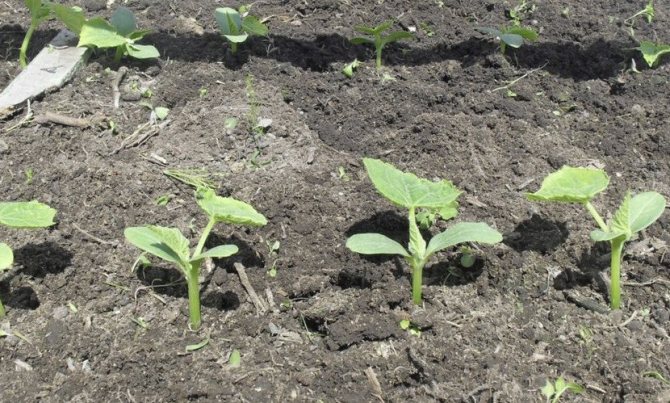

The place chosen for cucumbers should be well lit and protected from cold gusts of wind. In addition, make sure that zucchini, pumpkins, squash, melons, watermelons or other cucumbers are not grown on it before the cucumbers. More successful predecessors for plants of this variety will be tomatoes, onions, potatoes, carrots, legumes.
Description and characteristics of the variety
The hybrid has indeterminate bushes with predominantly female flowers. The ovaries grow in bouquets of 3-8 fruits. In total, the main lash brings up to 50 bouquets per season.
Zelens ripen 45-48 days after germination. Fruits appear before September.
The length of the greenery is 10-12 cm, the diameter is up to 3.5 cm. On average, the fruits weigh 100 g. The skin is covered with many noticeable tubercles. The pulp is juicy, tasty, crunches pleasantly.
Caring for cucumbers after planting
After planting in open soil, further care for Mother-in-law's cucumbers provides for the implementation of standard actions in the form of timely watering and fertilizing, loosening the soil and other measures to improve the condition of both the cucumbers themselves and the soil on which they grow.
Top dressing and irrigation regime
The first soil moistening after transplanting seedlings to a permanent place of growth is performed only after 2-3 days. In general, the period of active watering of cucumbers extends from the time of the appearance of the first shoots and until the very fruiting of the plant, after which the amount of applied liquid has to be significantly reduced.
Learn more about how to feed cucumbers with potassium, iodine, ash, yeast for a good harvest.
Before the appearance of ovaries, the regularity of watering is 1 time in 2-3 days or as the top soil layer dries up (it should not crack and become excessively compacted). One adult bush should have at least 2 liters of liquid settled in the sun, which is carefully poured under the root of the cucumbers.
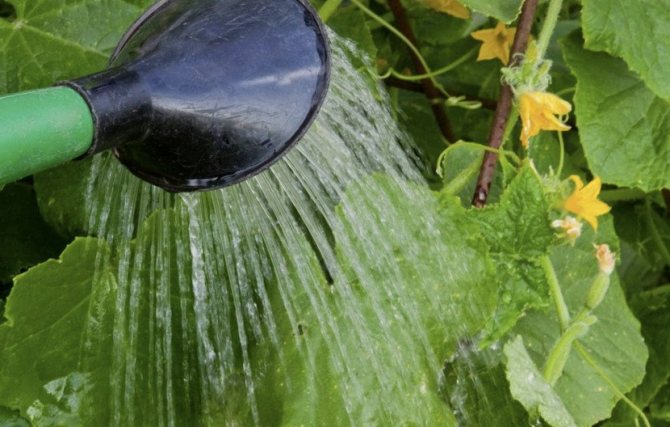

As fertilizers, which it is desirable to apply to the soil shortly after irrigation with warm water, you can use mullein diluted in water (1:10) or bird droppings in a ratio of 1:20.
Of the mineral dressings, potash, phosphorus and complex fertilizers will be useful for the Tesha variety. The most effective result from the use of nutrients can be obtained only with a combination of organic and mineral components: before the beginning of the growing season, vegetables need more nitrogen-containing substances, during flowering plants - phosphorus supplements, and at the peak of fruiting - potassium-containing compounds.
Periodic (once a month) foliar feeding with a solution of 1 liter of water, 1.5 g of potassium permanganate and the same amount of boric acid will not interfere with the variety. As for the regularity of fertilizers, then during the growing season of cucumbers they should be carried out no more than 1 time in 2 weeks.
Important! During the formation of ovaries and the beginning of fruiting, nitrogen-containing compounds will be especially undesirable for plants, contributing to an increased proliferation of leaves and stems to the detriment of fruit growth.
Bush garter and shaping
Despite the fact that the bushes of this variety of cucumbers are not too tall, the length of their lashes often reaches 2 m, which means that they still need a garter to a support, which will help to significantly reduce the likelihood of fruit rotting in the ground. In addition, well-ventilated parts of the plant will not suffer from pests and fungal diseases, therefore, as soon as the first whiskers and stems with 5-6 leaves appear on young bushes, they will have to be tied up.
In greenhouse conditions, the simplest option for performing this task would be to tie plants to a string stretched between metal reinforcement laid on the ground and the same segment fixed under the greenhouse roof. In open soil conditions, instead of it, you can stretch a net, with large meshes. The stems of growing cucumbers need to be regularly wrapped around the support in a clockwise direction, which repeats the trajectory of the sun across the sky (all plants are drawn to it).


The formation of plants begins almost simultaneously with their garter. Mother-in-law usually grows in one stem, often not limited in natural length. You can regulate the yield of shoots with the help of stepchildren appearing on the main stem. If the installed trellis or the height of the greenhouse requires limiting the growth of the culture, then pinch the top of the cucumbers and leave all the stepsons on the plant. If you are more interested in the high abundance of the crop, then you will have to remove all stepsons and collect fruits only from the main part of the bush.
Important! The more side shoots on the culture, the more light, water and nutrients are required, not to mention enough space for growth, which is far from always convenient.
All flowers and stepsons that form in the axils of the first 5 leaves should always be removed, and if you decide to leave the stepsons, then up to a height of 1 m they will have to be pinched over the second leaf. At a height of 1 to 1.5 m, such shoots are pinched over 3-4 leaves, and the uppermost stepchildren - above 5-6 leaves. The central shoot, which has reached its maximum length, must be thrown over the crossbar and left to grow down. It is advisable to remove leaf plates growing from below as the bush grows so that they do not get dirty with earth and do not cause the development of fungal ailments.
Soil care
Given the high frequency of watering during the growing season of Mother-in-law's cucumbers, the first thing to pay attention to when caring for the soil is loosening the top layer at some distance from the stem part. It is advisable to perform the procedure every week, but without deepening the tool more than 10-15 cm. Simultaneously with loosening, you can also harvest weeds, but in truth, they are terrible only for young and not yet matured crops. In the future, with a moderate thickening of the plantings and the correct garter of cucumbers, there should be no problems: it will be possible to remove weeds 3-4 times during the entire growing season.


Mulching and hilling cucumber bushes is performed after adding the next portion of liquid, but most often these procedures are performed only when there is a possibility of increased evaporation of moisture from the soil.
Disease and pest control
As in the case of other hybrid varieties, mother-in-law's cucumbers can be grown without actively fighting pests and diseases, especially if, from the moment of sowing the seeds to the very harvest, the gardener clearly follows all the requirements of agricultural technology.In rare cases, small brown-olive spots may still appear on the leaves and shoots of the culture, indicating the defeat of cucumbers by peronospora (downy mildew).


At the initial stages of the development of this ailment, treatment with milk whey will help to get rid of it, but in order to play it safe and protect your cucumbers from mass destruction, it is worth using more effective, special fungicidal preparations (for example, "Fitosporin-M" or "Gamair"). In the first case, the working solution is prepared at the rate of 40–50 ml per 10 l of water, and in the second, 10 tablets are dissolved in 10 l of water.
When signs of putrefactive processes appear on the stems of cucumbers, plants can be treated with compositions containing chalk, water and potassium permanganate, which are previously applied to a cotton swab, and then the plant itself is treated. The affected areas of the culture must be removed, which will serve as a good prevention of the further spread of the disease on the site. Additional preventive measures are:
- compliance with the rules of crop rotation;
- timely removal of all plant residues from the beds;
- weed control;
- compliance with the norms of watering and dressing.
Video: Prevention of cucumber diseases with folk remedies
Diseases and pests
Cucumbers varieties Mother-in-law and Zyatek have good immunity against many diseases and pests. However, with the wrong care, a weakened culture can become sick. Young shoots in most cases are susceptible to fungal diseases. They can be recognized by the presence of brown or black spots on the leaf plates. In older plants, as a result of the vital activity of fungi, the development of shoot rot, as well as yellowing of root crops, is usually observed.
One of the most dangerous diseases for cucumbers is peronosporosis, which is activated during sudden temperature and climatic changes. Excess moisture in the soil can also cause it. It can be recognized by the appearance of characteristic dark spots, which first appear on the leaves, and then quickly spread throughout the plant.
For the treatment of peronosporosis, experienced gardeners carry out the treatment of plants with a milk solution, which is prepared from equal proportions of water and milk.
Harvesting
A hybrid variety of cucumbers Mother-in-law is characterized by a gradual ripening of fruits, that is, the maximum amount of the crop indicated by the manufacturer on the package with seeds, you can collect not in one or two times, but for the whole season. To get the most crunchy and fragrant small fruits, you have to pick the greens every 2-3 days, not allowing them to outgrow.
Fresh harvested fruits can be stored in the refrigerator or basement for no longer than a week., therefore, those who want to prepare green plants for the winter will have to resort to the standard method - conservation. To bookmark the fruits for fresh storage, they must be wiped with a damp cloth and placed in a sealed plastic bag. Before canning, it is recommended to soak the greens in cold water for 8 hours, changing the liquid to fresh every 2 hours. For salting, no special preliminary preparation is required and after cleaning, you can immediately send the fruits to the jar.
Did you know? Cucumbers can be used not only for culinary purposes. Try rubbing the cut fruit on the bathroom mirror and you will get rid of the problem of fogging up while taking a bath.
Cucumbers of the hybrid variety Mother-in-law are a good option even for novice summer residents, because, despite the increased exactingness to care, the harvest of zelents always pleases with its quality and abundance. Agree, this is already a good reason to grow a culture on your site.
Features of the mother-in-law variety
Among modern hybrids, the mother-in-law variety is very popular. Moscow breeders created it over 10 years ago.
Variety characteristic:
- fruit length - up to 13 centimeters;
- the weight of one cucumber reaches 130 grams;
- collection from 1 bush - up to 6.5 kilograms.
The variety is classified as parthenocarpic, which means that the mother-in-law's cucumbers do not need pollination.
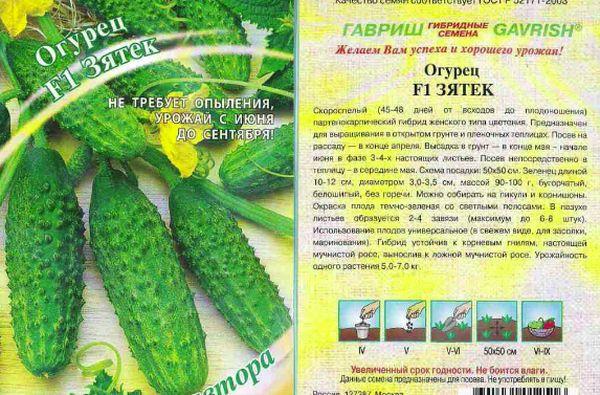

How to feed cucumbers Mother-in-law
Cucumber Mother-in-law responds well to fertilization, especially from mid-August - in this case, lateral shoots appear on the lashes, on which new ovaries appear.
Interesting!
Top dressing of cucumbers in the open field with folk remedies for a good harvest
Feeding cucumbers
It is recommended to apply top dressing for mother-in-law cucumbers every 10-12 days, alternating organic matter and mineral fertilizers containing phosphorus and potassium. If at the beginning of the season, ammonium nitrate or urea is usually used as a nitrogen-containing top dressing, then in the summer it is better to use liquid organic dressings - infusion of mullein or bird droppings.

